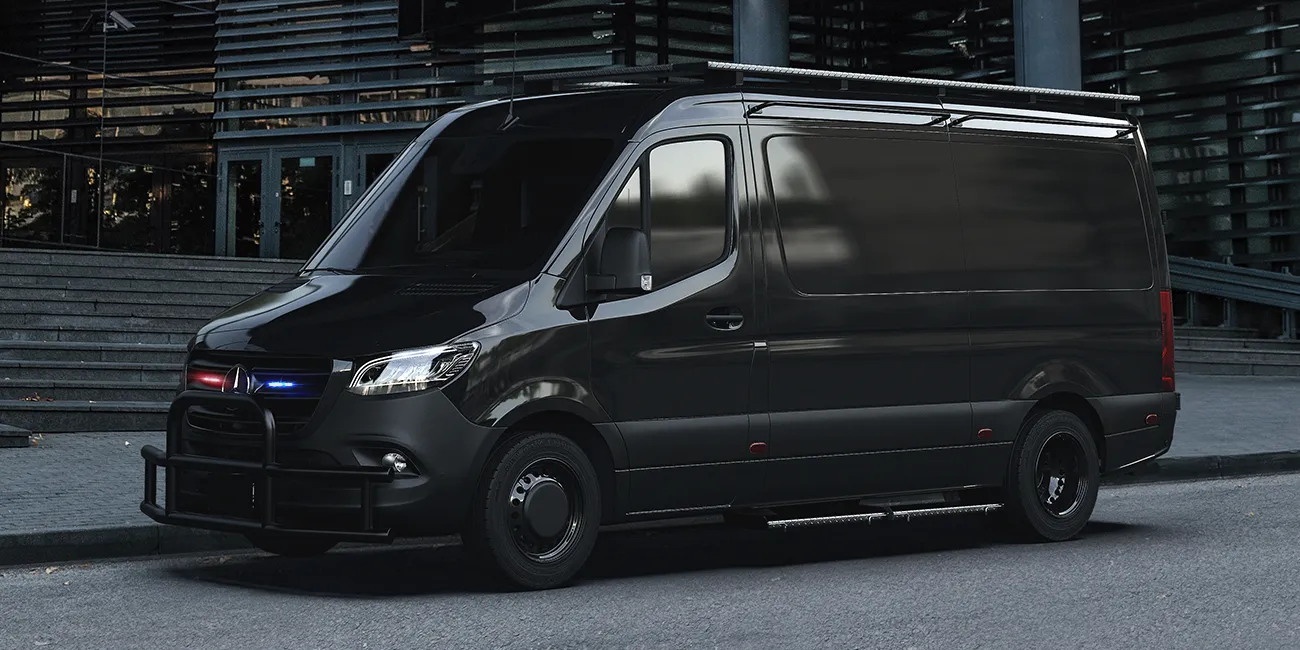A – Armored Personnel Carrier (APC)
Armored personnel carriers are versatile vehicles used by police for transporting officers and responding to high-risk situations.
B – Ballistic Protection
Ballistic protection refers to the vehicle armor and materials used to bulletproof police cars and shield personnel from gunfire.
C – (CBRN) Protection
Some armored vehicles are equipped with CBRN (Chemical, Biological, Radiological, and Nuclear) protection systems to safeguard against hazardous materials and toxic substance attacks. In the law enforcement industry, CBRN enhancements could be added to SWAT or special forces vehicles.
D – Deployment
Rapid deployment of armored vehicles is crucial for law enforcement during emergencies and tactical operations.
E – Emergency Response
Armored vehicles are vital for swift emergency response, ensuring the safety of officers and civilians.
F – Firearm Resistance
Armored police vehicles are designed to resist various firearms, providing a safe environment for officers in dangerous situations.
G – Gas Canisters
Some armored vehicles are equipped to handle tear gas canisters during riot control and crowd management.
H – Hostage Rescue
Armored vehicles play a pivotal role in hostage rescue operations, providing protection and mobility for SWAT teams.
I – Intelligence Gathering
Some advanced armored vehicles are equipped with surveillance and intelligence-gathering technology to support law enforcement efforts.
J – Joint Operations
Armored vehicles facilitate joint operations between law enforcement agencies, enhancing coordination and response capabilities.
K – Kevlar
Kevlar is a commonly used material in the construction of armored vehicles, providing high-strength, lightweight protection.
L – Less-Lethal Weapons
Armored vehicles may carry less-lethal weapons like tear gas launchers or rubber bullet systems for crowd control.
M – Mine-Resistant Ambush Protected (MRAP) Vehicles
MRAPs are military-grade armored vehicles made and adjusted for use by law enforcement units, offering 360 degree protection against explosive threats. These are used by anti-terror response teams or police in the highest-crime rated regions, for example, Haiti.
N – Non-lethal Countermeasures
Some armored vehicles are equipped with non-lethal countermeasures, like smoke screens, to disorient potential threats.
O – Observation Ports
Observation ports in armored vehicles allow officers inside to monitor the external environment without exposing themselves to danger.
P – Pursuit Operations
Armored vehicles can be used in pursuit operations to safely intercept and apprehend suspects in high-speed chases.
Q – Quick Deployment
The ability to quickly deploy armored vehicles is essential for responding to dynamic and time-sensitive situations.
R – Riot Control
Armored vehicles are deployed for riot control to protect officers and disperse crowds during civil unrest.
S – Special Weapons and Tactics (SWAT)
SWAT teams often rely on armored vehicles for their operations, including hostage rescue and barricaded suspect situations.
T – Tactical Operations
Armored vehicles play a central role in various tactical operations, providing cover and mobility to officers.
U – Undercover Operations
Armored Suburbans and other inconspicuous vehicles are used for undercover operations while maintaining protection.
V – VIP Protection
Armored vehicles are employed for VIP protection, safeguarding high-profile individuals from potential threats.
W – Water Cannon
Some armored vehicles are equipped with water cannons for riot control and crowd dispersal.
X – X-Ray Technologies
Law enforcement agencies continually explore experimental technologies to enhance armored vehicle capabilities.
Y – Yield to Emergency Vehicles
The public is encouraged to yield to armored emergency vehicles, ensuring a safe passage for officers during emergencies.
Z – Zero Emissions (Future Trend)
As a future trend, there’s a growing interest in developing armored police vehicles with zero emissions to reduce environmental impact.
Armored police vehicles represent the cornerstone of modern law enforcement, providing paramount protection for officers and civilians alike. These impressive machines, fortified with cutting-edge ballistic shielding and advanced technological features, fulfill a diverse array of roles, spanning from facilitating SWAT operations to ensuring the safety of VIPs. With a history that traces its roots back to the early 20th century, these vehicles underscore their enduring significance in upholding public safety.
As we look to the future, the evolution of armored police vehicles appears promising, with a shift towards employing lighter yet equally robust materials, embracing autonomous capabilities for enhanced safety, and integrating advanced communication systems to elevate operational efficiency and security.
For further insights and information on these crucial assets in law enforcement, reach out to Miami Armored®, your trusted partner for top-tier armored vehicles in Miami, Florida. With our expertise, you can delve deeper into the world of armored police vehicles.
